Metal and wooden soap molds will last you the longest, with proper maintenance potentially offering decades of use. You'll find metal molds resist warping and handle high temperatures well, while wooden molds stay reliable with regular mineral oil applications and proper storage. Both outperform plastic molds, which typically need replacement within two years, and silicone molds, which can stretch or discolor over time. Understanding each material's maintenance needs will maximize your mold's lifespan.
Understanding Different Soap Mold Materials
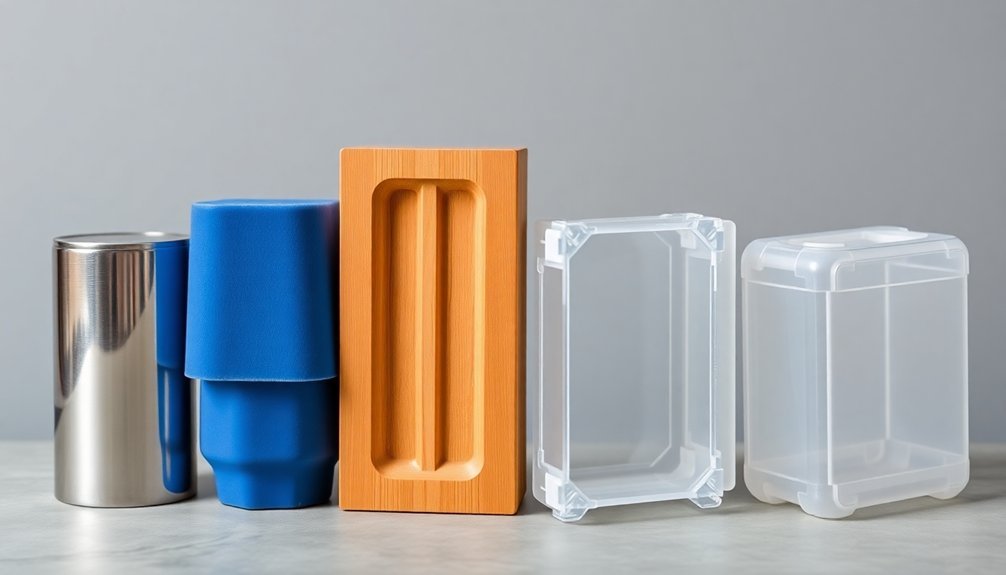
When choosing soap molds, you'll find that each material offers distinct advantages and limitations that affect both your soap-making process and final results.
Wooden molds, particularly pine ones, can serve you indefinitely if you maintain them properly and line them before use.
Pine wooden molds are a timeless choice for soap making, offering endless use when properly maintained and lined.
Silicone molds offer excellent flexibility and durability, making it easy to remove your soap from the mold while lasting for years with proper care.
Metal molds stand out as the most durable option, resisting warping and cracking, though they're pricier than other materials.
While plastic molds are common, they're less long-lasting and may deteriorate under high temperatures.
If you're considering recycled materials like cardboard, remember they're typically suitable for one-time use only and won't provide the reliability you'll find with more established materials.
Silicone Molds: Durability and Performance
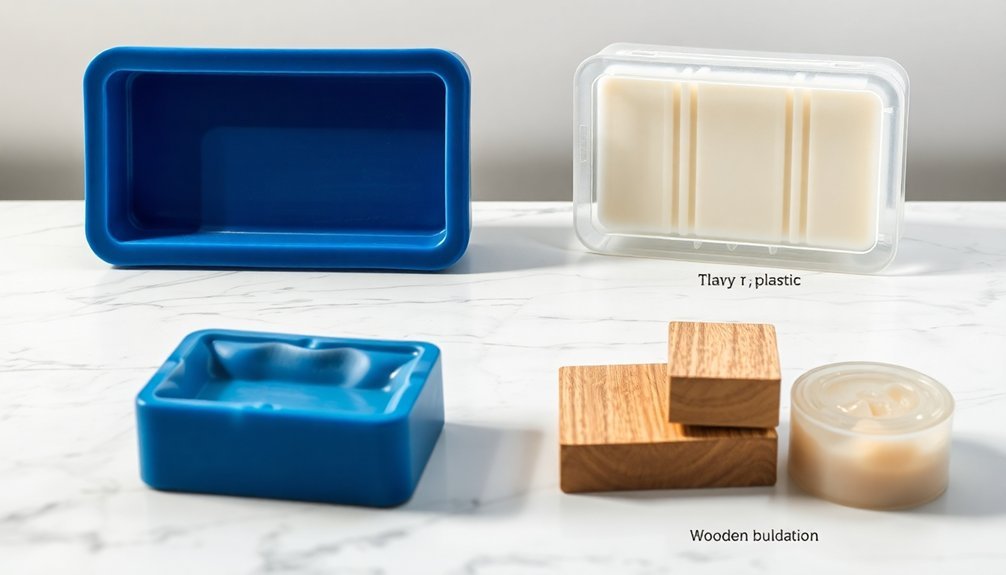
Among all soap mold materials, silicone stands out as a top performer for both hobbyists and professional soap makers.
You'll find that silicone molds offer exceptional durability, often lasting for years without warping or cracking, making them a smart investment for your soap-making venture.
What makes these molds particularly valuable is their flexible nature, allowing for easy removal of soap bars without damage.
They're non-toxic and can withstand temperatures up to 400°F, perfect for various soap-making techniques, including oven processing.
You won't need to worry about the molds absorbing scents or colors, as they maintain their integrity throughout repeated use.
To maximize their lifespan, maintain your silicone molds with regular cleaning using warm soapy water and proper storage, protecting them from unnecessary wear and tear.
Wooden Molds: Maintenance and Lifespan
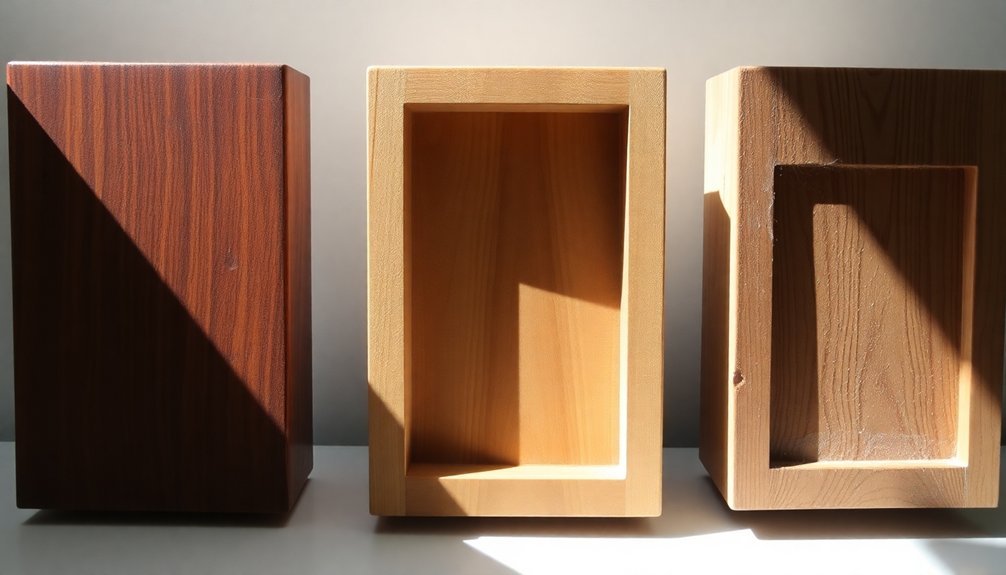
While silicone molds offer flexibility, wooden molds provide a traditional and sustainable option for soap making, provided you maintain them properly.
With proper care, your wooden molds can serve you indefinitely, but they'll require regular attention to maintain their integrity.
Invest time in caring for your wooden soap molds, and they'll reward you with years of reliable service and quality results.
To maximize your wooden molds' lifespan and prevent warping, follow these essential maintenance practices:
- Apply mineral oil regularly to protect the wood's finish and structure
- Store in a dry place away from direct sunlight to avoid damage
- Clean with a damp cloth instead of soaking in water
- Perform routine inspections for cracks or splits before each use
- Avoid exposing molds with glued seams to high heat during processing
Metal Molds: Long-term Investment Benefits
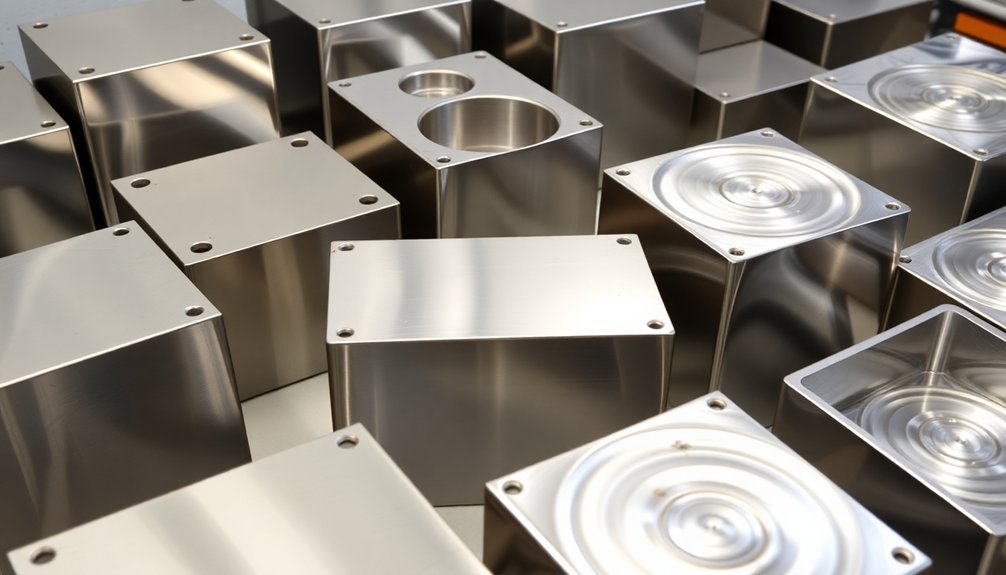
For soap makers seeking exceptional durability, metal molds represent the gold standard in soap-making equipment. You'll find their longevity unmatched, often lasting years with proper maintenance, making them a smart long-term investment despite higher upfront costs.
Unlike other materials, metal molds won't warp or crack under high temperatures, ensuring your soaps maintain consistent shapes. They're particularly effective for ideal gelling in cold process soaps, enhancing your final product's texture and appearance through superior insulation.
You'll appreciate practical features like removable sides, which make unmolding easier and protect your high-quality soap from damage.
While they may cost more initially, their ability to consistently produce professional results and their extended lifespan make metal molds a worthwhile investment for serious soap makers committed to quality production.
Plastic Molds: Limitations and Usage Span
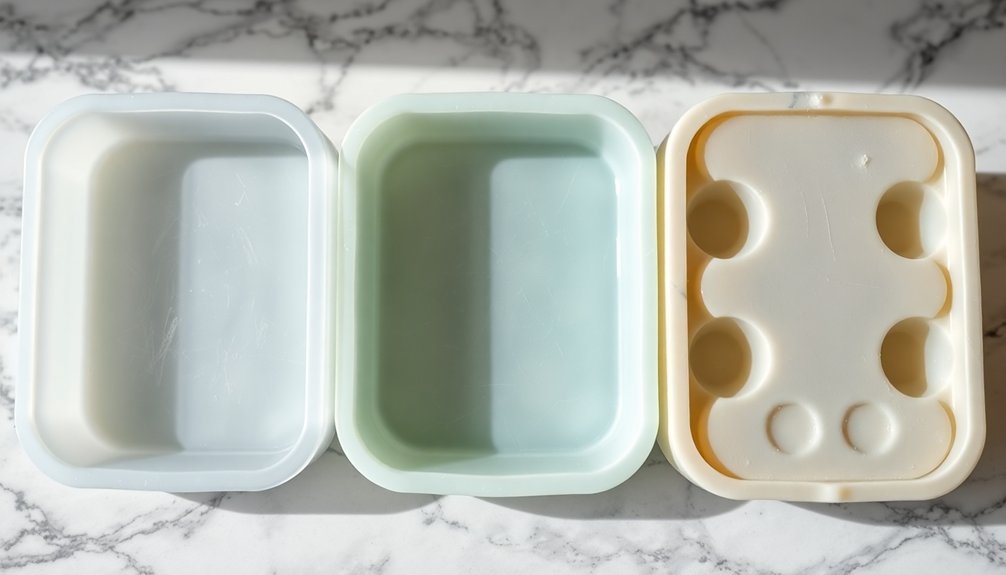
Despite their attractive price point, plastic molds present significant limitations that you'll need to contemplate before investing in them. While they're an affordable option and versatile in design, their lifespan typically ranges from a few months to two years, even with careful maintenance.
- Less durable construction makes them prone to warping and cracking with repeated use.
- Longer curing times required for cold process soap, which can affect production efficiency.
- Higher risk of soda ash formation on soap surfaces, requiring alcohol spritz treatment.
- Limited temperature resistance compared to metal or silicone alternatives.
- Regular replacement needed due to material degradation, potentially increasing long-term costs.
If you're just starting your soap-making journey, plastic molds might serve as an entry point, but their limitations make them better suited for occasional rather than professional use.
Environmental Factors Affecting Mold Longevity
Your soap molds' lifespan heavily depends on temperature control, as excessive heat can warp plastic molds and potentially damage even heat-resistant silicone ones.
Where you store your molds matters greatly – keeping them away from direct sunlight in a cool, shaded area will prevent degradation and maintain their shape integrity.
High humidity levels can be particularly damaging to wooden molds, causing warping and cracking, while proper storage in a dry environment will help preserve their functionality.
Temperature Effects on Molds
Temperature plays a critical role in how soap molds perform and endure over time. When you're choosing a mold material, you'll need to evaluate how each type reacts to heat and environmental conditions.
- Silicone molds offer excellent durability at high temperatures up to 400°F, though they can warp under direct sunlight.
- Metal molds resist warping and maintain their shape well, but they'll conduct heat quickly during the cooling process.
- Wooden molds provide great insulation for soap setting, yet they're vulnerable to humidity damage.
- Plastic molds have the lowest heat resistance and can easily warp or melt.
- All mold types require proper storage away from extreme temperatures.
To maximize your mold's lifespan, you'll want to store them in a temperature-controlled environment and avoid exposing them to sudden temperature changes that could compromise their structural integrity.
Storage Location Matters
Proper storage location can make or break the lifespan of your soap molds, regardless of their material type. You'll find that silicone molds offer superior durability when stored in cool, dry spaces away from direct sunlight. While wooden molds need extra attention to humidity and temperature fluctuations to prevent warping, proper storage considerably extends their lifespan.
| Storage Factor | Impact | Best Practice |
|---|---|---|
| Sunlight | Degrades materials | Store in dark area |
| Humidity | Causes warping | Keep in dry space |
| Temperature | Affects shape | Maintain consistent temp |
| Cleaning | Prevents deterioration | Clean before storing |
| Position | Maintains form | Store flat/upright |
Before storing your molds, verify thorough cleaning and drying to prevent mold growth and residue buildup. Your storage location should protect against environmental factors that could compromise your molds' structural integrity and long lifespan.
Humidity Impact Over Time
While humidity affects various soap mold materials differently, prolonged exposure to moisture can greatly impact their durability and performance.
You'll need to take into account how each material reacts to humid conditions when choosing your soap molds and planning their storage.
- Wooden soap molds are most vulnerable, warping and potentially developing mold growth in damp environments.
- Silicone molds offer the best humidity resistance, maintaining their shape and integrity across various climate conditions.
- Metal molds require thorough drying to prevent rust formation, which can compromise their longevity.
- Plastic molds may gradually warp or deform when exposed to consistent moisture.
- Climate-controlled storage considerably extends the lifespan of all mold types.
To maximize your molds' longevity, store them in a dry, temperature-controlled area and verify they're completely dry before putting them away.
Proper Storage Techniques for Extended Use
To maximize the lifespan of your soap molds, you'll need to implement careful storage practices that protect them from common environmental threats.
Store your silicone molds in a cool, dry location away from direct sunlight to maintain their shape and prevent material breakdown. For wooden molds, minimize exposure to moisture and sunlight to avoid warping and cracking.
Don't stack heavy items on top of your molds, as this can distort their shape and affect your future soap making results.
Before storing any of your long-lasting materials, verify they're completely clean and dry to prevent residue buildup.
Make it a habit to regularly inspect molds for signs of wear or damage – addressing problems early will help extend their usefulness and maintain the quality of your soap productions.
Signs of Mold Wear and Replacement Timing
Your soap molds will show clear warning signs when they're reaching the end of their usefulness, including warping, stickiness, or loss of shape that makes soap removal difficult.
The lifespan of your mold largely depends on its material, with silicone lasting several years, wood requiring vigilant maintenance, and plastic typically wearing out fastest due to heat exposure and cleaning stress.
Watch how your cleaning methods affect your molds over time, as harsh scrubbing or abrasive cleaners can greatly shorten their functional life.
Physical Damage Warning Signs
Since soap molds undergo regular use and exposure to various substances, recognizing signs of wear is essential for maintaining quality soap production.
You'll need to watch for visible tears, discoloration, and other forms of wear and tear that can affect your mold's performance.
Silicone molds, wooden molds, and plastic molds each display distinct warning signs when they're deteriorating.
- Silicone molds showing loss of flexibility or retaining persistent odors
- Wooden molds developing cracks, splits, or warping that affect shape
- Plastic molds becoming misshapen or losing their original form
- Stubborn soap residue that won't clean off despite thorough washing
- Noticeable discoloration or texture changes in any mold material
Regular inspection of your molds will help you identify these issues early, ensuring your soap-making process remains efficient and produces quality results.
Cleaning Impact Over Time
Regular cleaning routines, while necessary for maintaining soap molds, can gradually impact their longevity and performance.
You'll notice silicone molds showing signs of wear through discoloration, stickiness, or loss of flexibility, even with proper maintenance. When these symptoms persist despite thorough cleaning, it's time to contemplate replacement.
Wooden molds are more sensitive to cleaning impact, requiring careful attention to prevent warping and splitting.
If you're finding residue buildup that won't come off with gentle cleaning methods, your mold may be reaching the end of its useful life.
Regular inspection before each use is vital – check for deformities, rough surfaces, or persistent odors that could affect your soap quality.
Lifespan By Material Type
Different soap mold materials exhibit distinct lifespans and telltale signs of wear.
You'll find that each material requires specific maintenance to maintain its durability and guarantee consistent soap quality.
- Wooden molds can serve you indefinitely with regular mineral oil applications and proper care to prevent warping.
- Metal molds offer superior durability but need protection from rust to maintain their longevity.
- Silicone molds provide years of use but watch for stretching, persistent odors, or discoloration.
- Plastic molds have shorter lifespans and become brittle over time.
- All molds need replacement when they affect soap release or final product quality.
Your choice of mold material directly impacts your long-term soap making success.
Cost Versus Durability Analysis
When choosing a soap mold, you'll need to weigh the initial investment against long-term durability to make a cost-effective decision.
While plastic molds offer the lowest upfront cost, they're prone to warping and cracking, making them less economical for serious soap making.
Silicone molds provide excellent value, combining moderate pricing with years of reliable use without requiring additional lining.
Wooden molds, though pricier initially, can serve you indefinitely when maintained with mineral oil, proving their long-term value.
Metal molds represent the highest investment but can last decades with proper care, justifying their premium price tag.
Your usage frequency will impact cost-effectiveness markedly.
For regular soap makers, investing in silicone or wooden molds typically offers the best balance of durability and value over time.
Professional Versus Home Use Considerations
Professional soap makers and home crafters face distinct challenges that influence their mold selection.
While professional soap makers often invest in wood molds for their superior durability and insulation properties, home users might opt for more affordable options like silicone or plastic molds.
Consider these key factors when choosing your mold material:
- Wood molds offer indefinite longevity with proper maintenance, making them ideal for high-volume production.
- Silicone provides flexibility and easy cleaning, lasting several years for moderate use.
- Plastic molds are budget-friendly but less durable, better suited for occasional home use.
- High-quality materials guarantee consistent results and better return on investment.
- Custom molds can offer excellent longevity when constructed properly.
Your production volume and frequency should guide your choice between professional-grade and home-use materials to maximize both value and performance.
Material Combinations and Hybrid Solutions
You'll find that combining wood with silicone liners creates an ideal soap-making solution, offering both the insulation benefits of wood and the easy-release properties of silicone.
Metal molds reinforced with plastic components provide exceptional durability while preventing common issues like warping and sticking.
Wood-Silicone Liner Benefits
The integration of silicone liners with wooden molds represents a game-changing combination in soap making, offering crafters the best of both materials.
You'll find that wood molds provide exceptional durability while silicone liners add flexibility for easy soap removal. This powerful duo enhances your soaping experience by reducing maintenance requirements and protecting against moisture absorption.
- Get indefinite longevity from your wood molds with proper mineral oil care
- Enjoy simplified cleanup without additional lining materials
- Experience improved gelling capabilities due to wood's natural insulation
- Remove soaps effortlessly thanks to silicone's non-stick properties
- Protect your investment as silicone prevents wood warping over time
This hybrid approach combines wood's structural strength with silicone's practical benefits, creating an ideal solution that'll serve your soap making needs for years to come.
Metal-Plastic Reinforcement Solutions
While single-material molds have their merits, combining metal and plastic components creates a superior soap making solution that maximizes each material's strengths.
You'll find that hybrid molds offer the perfect balance between durability and ease of use, combining metal's structural integrity with plastic's versatility.
Consider using metal molds with a silicone liner – this combination provides excellent longevity while ensuring your soaps release easily.
The metal base offers superior insulation for proper gelling, while the flexible liner prevents sticking.
These reinforced designs outlast standard plastic molds, which often need replacement after repeated use.
You're investing in a long-term solution that won't warp or crack, even with frequent use.
The hybrid approach gives you the best of both worlds: the robustness of metal and the practical benefits of plastic or silicone materials.
Multi-Material Mold Construction
Savvy soap makers increasingly turn to multi-material mold construction for ideal results, recognizing that strategic material combinations release superior performance benefits.
You'll find that wood and silicone combinations offer exceptional structural integrity and heat retention, while metal frames with silicone inserts provide unmatched durability.
- Combining wood's insulation with silicone's flexibility creates molds that perform better and last longer
- Wooden molds lined with silicone prevent sticking while maintaining structural strength
- Metal frames paired with silicone inserts resist warping and enhance longevity
- Multi-material construction enables intricate designs impossible with single materials
- Regular maintenance, including cleaning silicone and oiling wood, guarantees lasting performance
For best results, you'll want to focus on proper maintenance of your multi-material molds, treating each component according to its specific needs.
Frequently Asked Questions
What Is the Best Material for Soap Molds?
You'll find silicone molds are your best choice due to their flexibility, durability, and ease of use. They won't warp, crack, or lose shape over time, making them perfect for consistent soap-making results.
How Long Can Soap Stay in Mold?
You'll want to remove your soap from molds within 24-48 hours. For cold process soap, don't exceed 48 hours. Melt and pour soaps can stay longer, up to 72 hours, but earlier removal's recommended.
How Long Does Silicone Mold Last?
You'll find that silicone molds can last 3-5 years or longer with proper care. If you maintain them well, clean them regularly, and avoid harsh chemicals, they'll keep their shape and non-stick properties intact.
What Is the Best Material to Make a Mold Out Of?
Metal is your best choice for mold-making, as it's incredibly durable and won't warp. If you need flexibility, silicone's a great alternative. Wooden molds are also excellent if you'll maintain them properly.
In Summary
When choosing your soap mold materials, silicone and stainless steel offer the longest-lasting options for your investment. You'll get years of use from high-quality silicone molds, while well-maintained metal molds can last decades. While wooden molds provide durability with proper care, they'll need more maintenance. Consider your production volume and budget, but remember that spending more upfront on quality materials often saves money long-term.

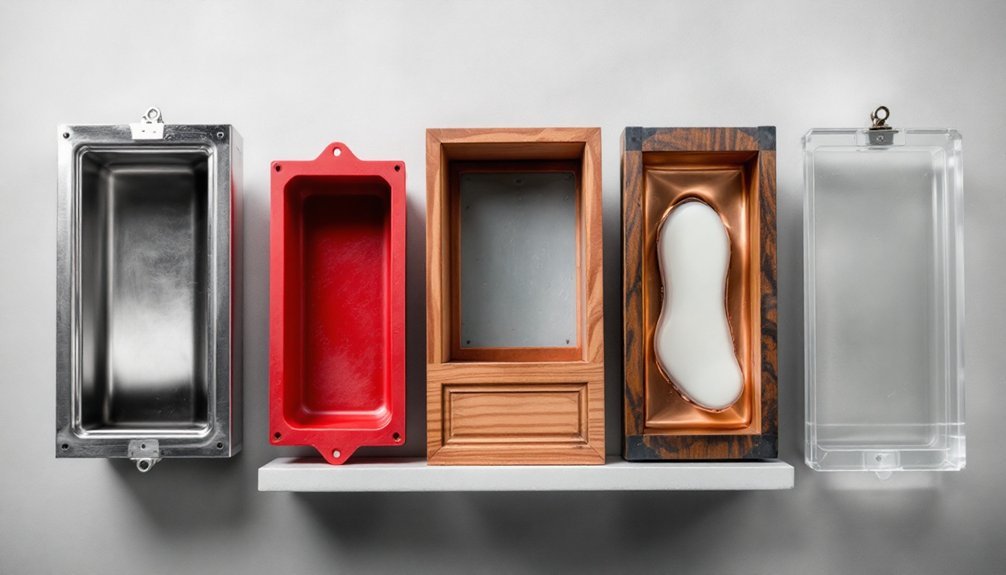



Leave a Reply